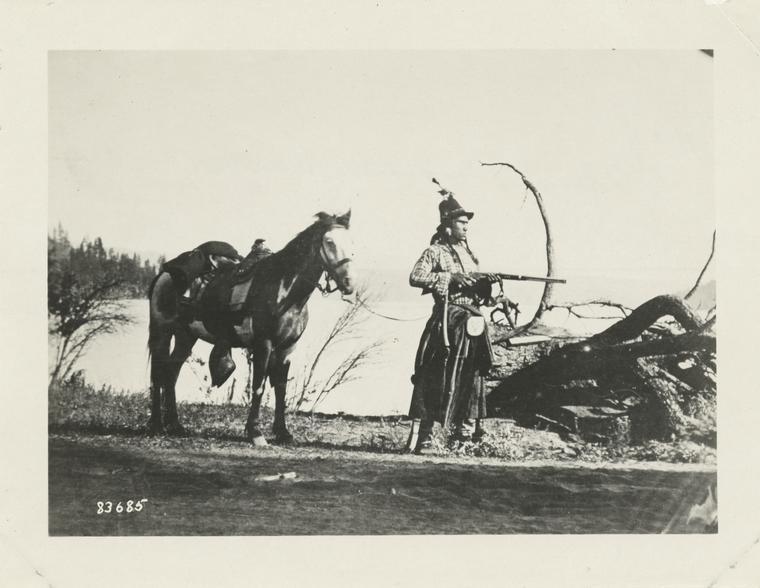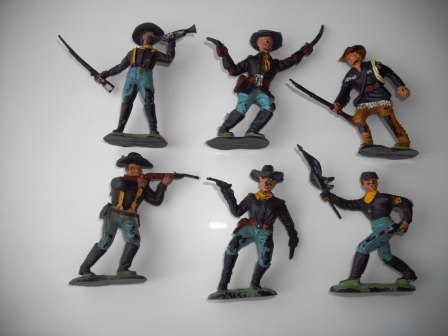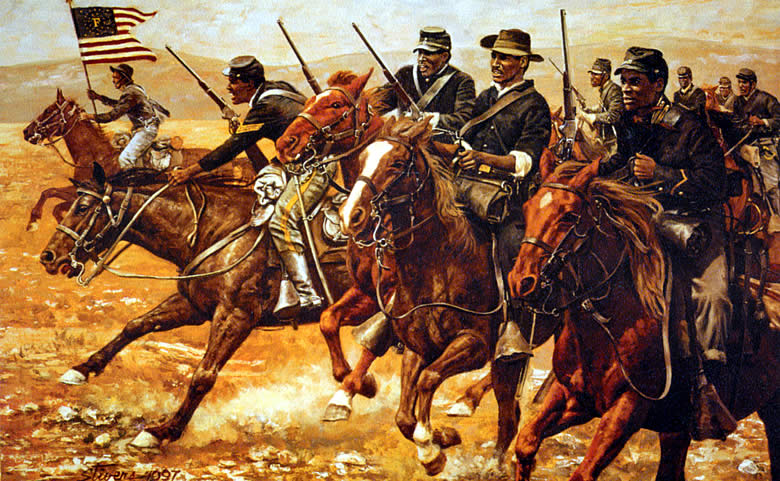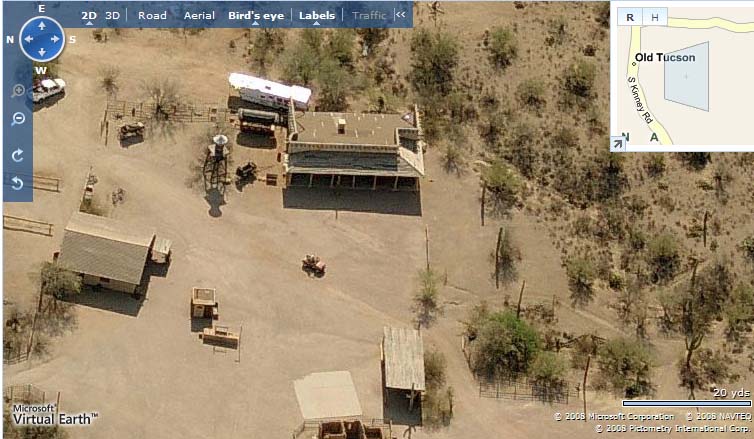Fort Bowie Ruins
|
 But there is a perennial spring here.
But there is a perennial spring here. The water just trickles now, but it was once a reliable enough source that travelers made it a point to stop; good water sources are few in the southwestern deserts.
The water just trickles now, but it was once a reliable enough source that travelers made it a point to stop; good water sources are few in the southwestern deserts. The spring at Apache Pass was an important resource and the Army built a post here in the 1860s to protect it – Fort Bowie.
The spring at Apache Pass was an important resource and the Army built a post here in the 1860s to protect it – Fort Bowie.
The location was a place where wildly different cultures came together and clashed. The lush desert mountain setting was a favorite camping place for Apaches and others who were traveling past. (below early American infantry in 1847 by Stadden) Quite possibly, white Americans first met Cochise here. Teamsters stopped at the spring for water while freighting from the Rio Grande Valley to Tucson. The Butterfield Overland Stage, (one of its routes below)
Quite possibly, white Americans first met Cochise here. Teamsters stopped at the spring for water while freighting from the Rio Grande Valley to Tucson. The Butterfield Overland Stage, (one of its routes below) America’s first trans-continental stagecoach company, built a station there. The Cochise War began (and ended) at Apache Pass and the Apache wars were finally brought to a close altogether at Fort Bowie in 1886.
America’s first trans-continental stagecoach company, built a station there. The Cochise War began (and ended) at Apache Pass and the Apache wars were finally brought to a close altogether at Fort Bowie in 1886. 
 America’s first trans-continental stagecoach company, built a station there. The Cochise War began (and ended) at Apache Pass and the Apache wars were finally brought to a close altogether at Fort Bowie in 1886.
America’s first trans-continental stagecoach company, built a station there. The Cochise War began (and ended) at Apache Pass and the Apache wars were finally brought to a close altogether at Fort Bowie in 1886.
Fort Bowie is south of Interstate 10 in southeastern Arizona. To get there, drive from Phoenix to Cochise, AZ, about 220 miles, and then took Apache Pass Road south about 15 miles to a trailhead. After a picnic lunch, its hiking boots for the walk to Fort Bowie. 

 Farther along the trail, you pass the now-abandoned post cemetery and the ruins of Tom Jeffords’ Chiricahua Apache Agency (the Chiricahua's first reservation was established here with Jeffords as agent at Cochise's request).
Farther along the trail, you pass the now-abandoned post cemetery and the ruins of Tom Jeffords’ Chiricahua Apache Agency (the Chiricahua's first reservation was established here with Jeffords as agent at Cochise's request).  While some Apaches did not trust him, Jeffords and Cochise were truly close friends; it was a very unusual relationship considering the realities of Indian-White interactions in frontier America. Beyond the agency ruin, (below Dulcop Italy)
While some Apaches did not trust him, Jeffords and Cochise were truly close friends; it was a very unusual relationship considering the realities of Indian-White interactions in frontier America. Beyond the agency ruin, (below Dulcop Italy)
Fort Bowie has not been “restored.” After closure in the 1890s, local residents came and stripped it of any and all useable building materials. (below Marx Frontierman) Over the years, rains washed away most of the remaining exposed adobe walls. As a result of its ruined condition, there is a mystical or feel to it – Because Fort Bowie is a ruin, (Below Marx)
Over the years, rains washed away most of the remaining exposed adobe walls. As a result of its ruined condition, there is a mystical or feel to it – Because Fort Bowie is a ruin, (Below Marx) you have only your imagination (and a few old photographs) to divine what it was like with hundreds of horse-mounted troops in residence or in review on the parade ground, and how the business of the Apache Wars kept things bustling.
you have only your imagination (and a few old photographs) to divine what it was like with hundreds of horse-mounted troops in residence or in review on the parade ground, and how the business of the Apache Wars kept things bustling.
Fort Bowie, from the hill above.
|
 The Apaches led by Mangas Coloradas, from their positions in the rocks above, had a commanding view of the soldiers as they approached the spring and firing down on them, were winning the fight, until the troopers deployed a couple of small field artillery pieces. Rather than risk heavy casualties from the bursting shells, the Apaches disengaged and disappeared, melting into the landscape like rainwater after a desert storm.(below Marx)
The Apaches led by Mangas Coloradas, from their positions in the rocks above, had a commanding view of the soldiers as they approached the spring and firing down on them, were winning the fight, until the troopers deployed a couple of small field artillery pieces. Rather than risk heavy casualties from the bursting shells, the Apaches disengaged and disappeared, melting into the landscape like rainwater after a desert storm.(below Marx)
e. You can see the foundation of the post commander’s home, and pick out stones still visible today and match them to the ones plainly visible in frontier-era photos of the house. You can pick out the exact spot where Geronimo stood for a photo, after his surrender in 1886. You can see the parade ground, the Stars and Stripes still flying over it, and imagine a troop of tired cavalry men – perhaps Buffalo Soldiers – as they awaited the order to “fall out” after a dusty, hot and tedious patrol through the deserts of southern Arizona and Sonora.(Marx)
W
W
A little more about Cochise and the Apaches..."Cochise" is a white bastardization of the Chiricahua leader's name -- the name was actually closer to "Cheis" which I am told means something like "has the strength, or quality, of oak."(marx) Cheis was one of very few Apache leaders of a few related southwestern bands who could unite and command respect from all of them as a group (the basic groups were the Chokonen or Chiricahua; Mimbres or Warm Springs and Chihenne or "Red Paint people," the Bedonkohe, and the Nednai or "those ahead at the end"). (marx)
Cheis was one of very few Apache leaders of a few related southwestern bands who could unite and command respect from all of them as a group (the basic groups were the Chokonen or Chiricahua; Mimbres or Warm Springs and Chihenne or "Red Paint people," the Bedonkohe, and the Nednai or "those ahead at the end"). (marx) They were usually separated into smaller, familial groups. Leaders of these groups (in their last days as free peoples) included Cheis, Mangas Coloradas, Victorio and Nana, Naiche, Geronimo and Juh. The Bedonkohe were centered in the Gila River headwaters area around present day Clifton, AZ. The Chokonen with Cheis were further south in the area of the Chiricahua Natl (below Marx a much more honest rendition of the cavalry, much better than Dulcop,that is crap but good pistols on them, I hear conversion)
They were usually separated into smaller, familial groups. Leaders of these groups (in their last days as free peoples) included Cheis, Mangas Coloradas, Victorio and Nana, Naiche, Geronimo and Juh. The Bedonkohe were centered in the Gila River headwaters area around present day Clifton, AZ. The Chokonen with Cheis were further south in the area of the Chiricahua Natl (below Marx a much more honest rendition of the cavalry, much better than Dulcop,that is crap but good pistols on them, I hear conversion) Monument and Ft Bowie; the Warm Springs, Mimbres, Chihenne groups were located around Silver City, NM; the Nednai considered the fastnesses of the Sierra Madres of Sonora and Chihuahua their homelands. All these groups ranged widely over the whole Arizona/New Mexico/Sonora landscape.
Monument and Ft Bowie; the Warm Springs, Mimbres, Chihenne groups were located around Silver City, NM; the Nednai considered the fastnesses of the Sierra Madres of Sonora and Chihuahua their homelands. All these groups ranged widely over the whole Arizona/New Mexico/Sonora landscape.
The High Chaparral,
The ranch house that still stands on the location set at Old Tucson was built for exterior shots only, so the inside is empty. According to Kent McCray, producer for The High Chaparral, "The Art Director on Bonanza, Earl Hedrick, designed and built the exterior of The High Chaparral at Old Tucson. All of Earl Hedrick's plans were destroyed and are non existent."
All of the familiar rooms and decorations we've all come to expect from the episodes were shot on various soundstages. "The interior set was on the stage at Paramount Studios. Later when we left Paramount for Warner Brothers Studios, a new interior set was built on our Warner Brothers stage. Bob Shelton (ed. note: owner/originator of Old Tucson Studios) purchased the interior set at Paramount and put it on the Old Tucson stage," Kent said.

The logistics of the actual floor plan is another piece of Hollywood sleight of hand, because if you take the layout apart carefully, using the evidence shown in the TV show, you'll find that it's impossible to reconcile what's shown with what is physically possible. We all know there is a second floor to the house, containing various bedrooms. But if you look carefully, you'll see that the steps only allow for about a half floor, yet there's John's office, the kitchen, and also some other unseen rooms behind the main living room that must fit underneath the second floor. In various episodes John and Victoria's bedroom seems to be either on the second floor or on the ground level – or maybe they move back and forth for variety. The High Chaparral website provides an excellent explanation and estimated layout of the floor plan, as well as screen shots from the series detailing the rooms.

One High Chaparral fan dealt with all these issues (and many more) when he decided to build a true to life replica of the ranch house set. Ronnie Rubino's home is so exactly like the High Chaparral that it's startling to be inside it. Having had the pleasure of visiting Ronnie's house, I can tell you The High Chaparral ranch house is a comfortable, lovely place, and would have been a very impressive house in 1870's Arizona.
 It's certainly a beautiful home today.
It's certainly a beautiful home today.
Because the ranch itself was actually a major character in the series, various legendary stores have built up around its creation and history.  Occasionally you may hear the design was based on the original Pete Kitchen ranch house, that there was already a building on the Old Tucson lot which the HC crew remodeled, or that the ranch set changed between the pilot and the regular first season series. About the Pete Kitchen theory,Kent McCray says, "I have no clue," but for the rest he can set the record straight, since he was there at the beginning and throughout every episode. "The ranch set never changed between the pilot and the first season, and there was not any building on the Old Tucson property before that."
Occasionally you may hear the design was based on the original Pete Kitchen ranch house, that there was already a building on the Old Tucson lot which the HC crew remodeled, or that the ranch set changed between the pilot and the regular first season series. About the Pete Kitchen theory,Kent McCray says, "I have no clue," but for the rest he can set the record straight, since he was there at the beginning and throughout every episode. "The ranch set never changed between the pilot and the first season, and there was not any building on the Old Tucson property before that."
 Occasionally you may hear the design was based on the original Pete Kitchen ranch house, that there was already a building on the Old Tucson lot which the HC crew remodeled, or that the ranch set changed between the pilot and the regular first season series. About the Pete Kitchen theory,Kent McCray says, "I have no clue," but for the rest he can set the record straight, since he was there at the beginning and throughout every episode. "The ranch set never changed between the pilot and the first season, and there was not any building on the Old Tucson property before that."
Occasionally you may hear the design was based on the original Pete Kitchen ranch house, that there was already a building on the Old Tucson lot which the HC crew remodeled, or that the ranch set changed between the pilot and the regular first season series. About the Pete Kitchen theory,Kent McCray says, "I have no clue," but for the rest he can set the record straight, since he was there at the beginning and throughout every episode. "The ranch set never changed between the pilot and the first season, and there was not any building on the Old Tucson property before that."


No comments:
Post a Comment